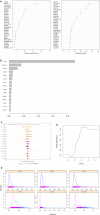Ensemble-AHTPpred: A Robust Ensemble Machine Learning Model Integrated With a New Composite Feature for Identifying Antihypertensive Peptides
- PMID: 35571042
- PMCID: PMC9096110
- DOI: 10.3389/fgene.2022.883766
Ensemble-AHTPpred: A Robust Ensemble Machine Learning Model Integrated With a New Composite Feature for Identifying Antihypertensive Peptides
Abstract
Hypertension or elevated blood pressure is a serious medical condition that significantly increases the risks of cardiovascular disease, heart disease, diabetes, stroke, kidney disease, and other health problems, that affect people worldwide. Thus, hypertension is one of the major global causes of premature death. Regarding the prevention and treatment of hypertension with no or few side effects, antihypertensive peptides (AHTPs) obtained from natural sources might be useful as nutraceuticals. Therefore, the search for alternative/novel AHTPs in food or natural sources has received much attention, as AHTPs may be functional agents for human health. AHTPs have been observed in diverse organisms, although many of them remain underinvestigated. The identification of peptides with antihypertensive activity in the laboratory is time- and resource-consuming. Alternatively, computational methods based on robust machine learning can identify or screen potential AHTP candidates prior to experimental verification. In this paper, we propose Ensemble-AHTPpred, an ensemble machine learning algorithm composed of a random forest (RF), a support vector machine (SVM), and extreme gradient boosting (XGB), with the aim of integrating diverse heterogeneous algorithms to enhance the robustness of the final predictive model. The selected feature set includes various computed features, such as various physicochemical properties, amino acid compositions (AACs), transitions, n-grams, and secondary structure-related information; these features are able to learn more information in terms of analyzing or explaining the characteristics of the predicted peptide. In addition, the tool is integrated with a newly proposed composite feature (generated based on a logistic regression function) that combines various feature aspects to enable improved AHTP characterization. Our tool, Ensemble-AHTPpred, achieved an overall accuracy above 90% on independent test data. Additionally, the approach was applied to novel experimentally validated AHTPs, obtained from recent studies, which did not overlap with the training and test datasets, and the tool could precisely predict these AHTPs.
Keywords: ACE inhibitor; ACE inhibitory peptide; antihypertensive; classification; ensemble machine learning; prediction.
Copyright © 2022 Lertampaiporn, Hongsthong, Wattanapornprom and Thammarongtham.
Conflict of interest statement
The authors declare that the research was conducted in the absence of any commercial or financial relationships that could be construed as a potential conflict of interest.
Figures







References
-
- Ankhi H., Madhushrita D., K D. T. D., Pubali D., Jana C. (2022). Isolation of an Antihypertensive Bioactive Peptide from the Freshwater Mussel Lamellidens Marginalis. Int. J. Food Nutr. Sci. 11, 1–8. 10.54876/ijfans_01-08 - DOI
-
- Asoodeh A., Homayouni-Tabrizi M., Shabestarian H., Emtenani S., Emtenani S. (2016). Biochemical Characterization of a Novel Antioxidant and Angiotensin I-Converting Enzyme Inhibitory Peptide from Struthio camelus Egg white Protein Hydrolysis. J. Food Drug Anal. 24 (2), 332–342. 10.1016/j.jfda.2015.11.010 - DOI - PMC - PubMed
-
- Balgir P. P., Sharma M. (2017). Biopharmaceutical Potential of ACE-Inhibitory Peptides. J. Proteomics Bioinform. 10, 171–177. 10.4172/jpb.1000437 - DOI
LinkOut - more resources
Full Text Sources
Miscellaneous

